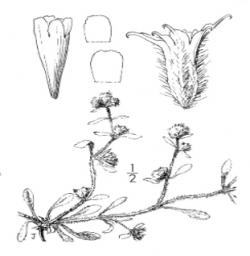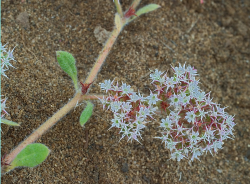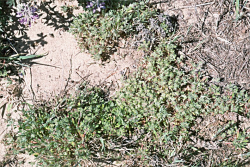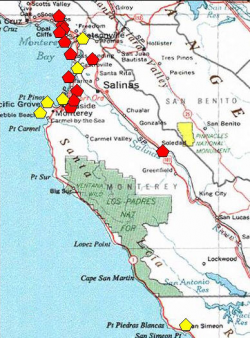
threatened

Illustration from Abrams (1944).

Photo taken in Aptos © 2006 Aaron Schusteff.

Photo taken at Sunset State Beach, Santa Cruz County by Dean W. Taylor.

A red polygon indicates an extant occurrence; yellow indicates the occurrence has been extirpated.



This fact sheet was prepared by Dylan M. Neubauer under award NA04N0S4200074 from the National Oceanic and Atmospheric Administration (NOAA), U.S. Department of Commerce (DOC). The statements, findings, conclusions, and recommendations are those of the authors and do not necessarily reflect the views of the NOAA or the DOC.
© Copyright 2006, Elkhorn Slough Coastal Training Program
Last updated: Jul 31, 2021 20:14
Common Names - Monterey spineflower
Family - Polygonaceae (Buckwheat Family)
State Status - none
Federal Status - federal threatened
(February 1994)
Habitat
Pleistocene marine sand deposits and recent dunes along the inner flanks of the Monterey Bay, growing in openings in dune scrub, sandy openings in maritime chaparral, and recent sandy alluvium in a riparian community with open cover of sandbar willow (Salix exigua var. hindsiana); < 65 m.
Key Characteristics
Annual herb, prostrate, < 1.5 dm tall (inland plants suberect and < 2.5 dm tall), gray-villous throughout; leaves in basal rosette and at lowest few nodes, oblanceolate, blades 1–5 cm; inflorescence dense, cymose, with secondary branches not evident except as terminal inflorescence expressions; bracts 2, opposite, awned; involucre 3-angled, 6-ribbed, tube 2–3 mm long, swollen, transversely ridged, teeth 6, w/ margins white or occasionally pinkish, awns 1-3 mm, hooked; perianth 2-colored, tube white, lobes white to rose, jagged; stamens 9 (Reveal and Rosatti 2014). Superfically similar to diffuse spineflower (C. diffusa), which in our region is known to be sympatric with only the Ben Lomond spineflower (C. pungens var. hartwegiana).
Flowering Period
April to June
Reference Populations
Manzanita County Park, Salinas River State Beach, Fort Ord National Monument (Monterey County); Sunset State Beach, Manresa State Beach (Santa Cruz County).
Global Distribution
Endemic to the central coast of California in San Luis Obispo (presumably extirpated), Monterey, and Santa Cruz counties.
Conservation
At one time this species was probably widespread in dune and dune margin habitats over the entire region of Monterey Bay. It also extended inland into the lower Salinas Valley, where the plants tend to be more erect and have somewhat less well-developed involucral margins and may be a distinct taxon (Ertter 1996).
A 2009 genetic study of the Pungentes subsection of Chorizanthe (Brinegar and Baron) suggests that the coastal-growing Monterey spineflower is more closely related to the coastal-growing robust spineflower (C. robusta var. robusta) than to the inland-growing Ben Lomond spineflower (C. pungens var. hartwegiana). And, the inland-growing Ben Lomond spineflower is more closely related to the inland-growing Scotts Valley spineflower (C. robusta var. hartwegii) than to the coastal-growing Monterey spineflower. The current Jepson Manual/eFlora treatment (Reveal 2013) does not reflect this information.
A 2006 study found that Monterey spineflower seed germinates readily in most years under a wide range of winter conditions and does not develop a long-lived seedbank. Seedling abundance reflects recent additions and depletions of its seedbank, rather than the prevailing weather (Fox et al.).
The populations in the hills between Watsonville and Aptos are small, declining, and have been impacted by developments throughout the 1990s. Populations at the Moss Landing Marine Lab, the Naval Postgraduate School, and Asilomar State Beach and elsewhere under management, including eradication of non-native ice plant (Carpobrotus spp.). The San Simeon population is presumed extirpated, being based on a single herbarium specimen collected in 1842. The Soledad site was, in 2004, a dense willow thicket; searches along the river floodplain are needed.
References
Abrams, L. 1944. Illustrated Flora of the Pacific States, Vol. 2. Stanford University Press, Palo Alto, CA.
Brinegar, C. and S. Baron. 2009. Molecular phylogeny of the Pungentes subsection of Chorizanthe (Polyognaceae: Eriogonoideae) with emphasis on the phylogeography of the C. pungens–C. robusta complex. Madroño 56(3):168–183.
CNPS, Rare Plant Program. 2015. Chorizanthe pungens var. pungens in Inventory of Rare and Endangered Plants (online edition, v8-02). California Native Plant Society, Sacramento, CA. http://www.rareplants.cnps.org/detail/473.html [accessed 3 February 2015].
Ertter, B. 1996. Saga of the Santa Cruz spineflower. Fremontia 24(4):8–11.
Fox, L. R., H. N. Steele, K. D. Holl, M. H. Fusari. 2006. Contrasting demographies and persistence of rare annual plants in highly variable environments. Plant Ecology 183(1):157–170.
Reveal J. L. and T. J. Rosatti. 2013. Chorizanthe pungens var. pungens, in Jepson Flora Project (eds.). Jepson eFlora, http://ucjeps.berkeley.edu/cgi-bin/get_IJM.pl?tid=56501 [accessed 3 February 2015].
U.S. Fish and Wildlife Service (USFWS). 2009. Monterey spineflower (Chorizanthe pungens var. pungens) 5-year review: summary and evaluation. Ventura Fish and Wildlife Office, Ventura, CA. http://ecos.fws.gov/docs/five_year_review/doc2393.pdf [accessed 3 February 2015].
